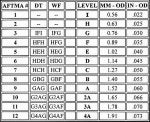If you find yourself in possession of a vintage rod and find that there are a series of letters on the butt section but no indication of what line is recommended have a look at the chart below.
Before the AFTMA system became the standard rods and fly lines alike were labeled with a code. While the code may have been fun and mysterious I think we can agree that it's easier to say I have a 5 weight then saying, Mine is an HEH - HEG, what's yours?
Before the AFTMA system became the standard rods and fly lines alike were labeled with a code. While the code may have been fun and mysterious I think we can agree that it's easier to say I have a 5 weight then saying, Mine is an HEH - HEG, what's yours?
Last edited:

